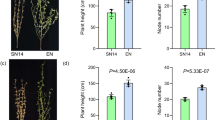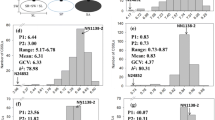Abstract
Thicker, erect stem and enlarged seeds are characteristic of the domestication of cultivated soybeans (Glycine max) from its progenitor, wild soybean (G. soja). Wild soybeans have different stem thicknesses but the thick stem as defined here appears in a small number of small-seeded wild soybeans (≤2.0 g/100-seeds) in China. However, little attention has been paid to this phenomenon in considering the origin of thick stem in wild soybean. Here, we addressed this question through the study of a mixed field of wild, semi-wild and cultivated soybeans. Thick-stemmed samples had lower sensitivity to light period, higher mean genetic diversity (H e = 0.090, H = 0.535) and higher mean multilocus outcrossing rate (t m = 9.77 %), while thin-stemmed plants were the opposite (H e = 0.029, H = 0.416) and lower mean outcrossing rate (t m = 5.88 %). F statistics calculations indicated that there was genetic differentiation between the thin and thick stems. UPGM cluster analysis showed that not only were thick-stemmed wild soybeans genetically different from thin-stemmed ones, but they were also genetically closer to semi-wild soybean, to varying degrees completely dependent on seed size. These data strongly implied that the plants with thick stems had more complicated genetic backgrounds than the thin-stemmed ones, and that they were related to cultivated soybeans. This study suggests that if plants have distinctly thick stems (an average 2.5-fold thicker than other thin-stemmed plants) or stems similar to semi-wild plants and/or near to local soybeans in a natural wild population adjacent to farmlands, such plants could be cultivar-introgressive offspring.


Similar content being viewed by others
References
Abe J, Hasegawa A, Fukushi H, Mikami T, Ohara M, Shimamoto Y (1999) Introgression between wild and cultivated soybean of Japan revealed by RFLP analysis for chloroplast DNA. Econ Bot 53:285–291
Carter TE, Nelson R, Sneller CH, Cui Z (2004) Volume agronomy no. 16. In: Boerma HR, Sprcht JE (eds) Soybean: improvement, production, and uses. American Society of Agronomy, Soil Science Society of American, Crop Science Society of American, Madison, pp 303–416
Close PS, Shoemaker RC, Keim P (1989) Distribution of restriction site polymorphism within the chloroplast genome of the genus Glycine, subgenus Soja. Theor Appl Genet 77:768–776
Cregan PB, Jarvik T, Bush AL, Shoemaker RC, Lark KG, Kahler AL, Kaya N, Vantoai TT, Lohnes DG, Chung J, Specht JE (1999) An integrated genetic linkage map of the soybean genome. Crop Sci 39:1464–1490
Goudet J (2001) FSTAT, a program to estimate and test gene diversities and fixation indices (version 2.9.3). Lausanne University, Switzerland
Hymowitz Y (1970) On the domestication of the soybean. Econ Bot 24:408–421
Hyten DL, Song QJ, Zhu YL, Choi IY, Nelson RL, Costa JM, Specht JE, Shoemaker RC, Cregan RB (2006) Impacts of genetic bottlenecks on soybean genome diversity. Proc Natl Acad Sci USA 103:16666–16674
Liu K, Muse SV (2005) Powermarker: integrated analysis envinment for genetic markerdate. Bioinformatics 21:2128–2129
Liu Y, Li XH, Xiao XH, Wang KJ (2010) Genetic divergence in different seed weights within the subgenus Soja and taxonomic assignment of semi-wild soybean (Glycine gracilis Skvortzow). (China). Mol Plant Breed 8:231–239
Pritchard JK, Stephens M, Donnelly P (2000) Inference of population structure using multilocus genotype data. Genetics 155:945–959
Shoemaker RC, Hatpopulation PM, Palmer RG, Atherly AG (1986) Chloroplast DNA variation in the genus Glycine subgenus Soja. Heredity 77:26–30
Sisson HD, Brim CA, Levings CS (1978) III. Characterization of cytoplasmic diversity in soybeans by restriction endonuclease analysis. Crop Sci 18:991–996
Skvortzow BV (1927) The soybean–wild and cultivated in Eastern Asia. Proc Manchurian Res Soc Nat History Sect Publ Ser A 22:1–8
Wang JL (1961) Evolution, classification, cultivation and breeding of soybeans. (China). J Northeast Agric Coll 1-2:1–6
Wang LZ (2007) The origin, evolution and dissemination of soybeans. In: Wang LZ, Guo QY (eds) The modern soybeans in China. Jindun Publishing House, Beijing, pp 27–44
Wang KJ, Li XH (2011a) Interspecific gene flow and the origin of semi-wild soybean revealed by capturing the natural occurrence of introgression between wild and cultivated soybean populations. Plant Breed 130:117–127
Wang KJ, Li XH (2011b) Genetic differentiation and diversity of phenotypic characters in Chinese wild soybean (Glycine soja Sieb. & Zucc.) revealed by nuclear SSR markers and the implication for intraspecies phylogenic relationship of characters. Genet Resour Crop Evol 58:209–223
Wang KJ, Li XH (2012a) Phylogenetic relationships, interspecific hybridization and origin of some rare characters of wild soybean in the subgenus Glycine Soja in China. Genet Resour Crop Evol 59:1673–1685
Wang KJ, Li XH (2012b) Genetic characterization and gene flow in different geographical—distance neighbouring natural populations of wild soybean (Glycine soja) Sieb. & Zucc.) and implications for protection from GM soybeans. Euphytica 186:817–830
Wang KJ, Li XH, Li FS (2008) Phenotypic diversity of the big seed type subcollection of wild soybean (Glycine soja Sieb. et Zucc.) in China. Genet Resour Crop Evol 55:1335–1346
Wang KJ, Li XH, Zhang JJ, Chen H, Zhang ZL, Yu GD (2010) Natural introgression from cultivated soybean (Glycine max) into wild soybean (Glycine soja) with the implications for origin of populations of semi-wild type and for biosafety of wild species in China. Genet Resour Crop Evol 57:747–776
Wang KJ, Li XH, Liu Y (2012) Fine phylogenic-genetic structure and major events in the history of the current wild soybean (Glycine Soja) and taxonomic assignment of semi-wild type (Glycine gracilis Skvortz.) within the Chinese subgenus Soja. J Hered 103:13–27
Weir BS (1996) Methods for discrete population genetic data., Genetic data analysis IISinauer Associates, Sunderland
Yeh FC, Yang RC, Boyle T (1999) POPGENE software package version 1.31 for population genetic analysis. University of Alberta, Edmonton
Zhao TJ, Gai JY (2004) The origin and evolution of cultivated soybean [Glycine max (L.) Merr.]. Sci Agri Sin 37:954–962 In chinese
Acknowledgments
This work was supported by the “973 National Basic Research Program of China (Item no. 2010CB125903)” from the Ministry of Science and Technology of the People’s Republic of China, the “Environmental and Biosafety Assessment of Transgenic Maize, Soybean and Wheat (Item no. 2008ZX08011-003)” from the Chinese Ministry of Agriculture, and “Sci & Teck Innovation Program of Chinese Academy of Agricultural Sciences”.
Author information
Authors and Affiliations
Corresponding author
Additional information
X.-H. Li was equally the first author.
Rights and permissions
About this article
Cite this article
Wang, KJ., Li, XH. The possible origin of thick stem in Chinese wild soybean (Glycine soja). Plant Syst Evol 300, 1079–1087 (2014). https://doi.org/10.1007/s00606-013-0946-z
Received:
Accepted:
Published:
Issue Date:
DOI: https://doi.org/10.1007/s00606-013-0946-z




